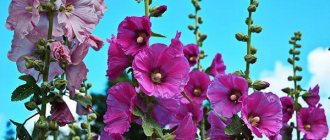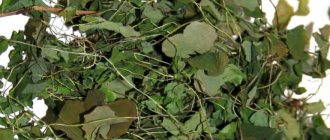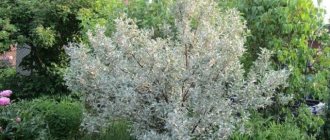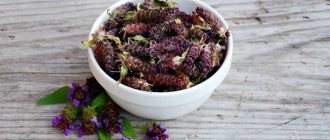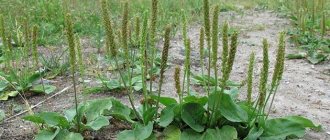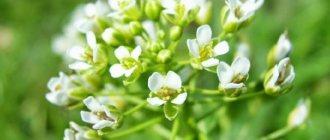Description
Mallow is a beautiful biennial plant, widespread in Russia. Another official name of the plant is Mallow. It grows in the form of a herbaceous flower. The mallow bush is a creeping, less often erect, plant. the stem reaches 1.5 meters.
The roots of the mallow are very long and creeping. A large number of appendages emanate from the central root, which firmly hold the plant in the ground.
The stem of the mallow is a long, creeping or erect herbaceous flagellum up to 1.2 meters long. At the beginning of growth, spines are present on the stem, but as they increase in size and age, the spines fall off. What remains is a bare stem of a light green hue. Many branches extend from the stem, on which leaves are located on long petioles.
Mallow leaves are shaped like a heart. The foliage is located on long petioles. The mallow leaf is a round plate with several lobes. Some varieties have drooping leaves and notched edges. The leaves have a rich, juicy, bright green hue.
A peduncle grows from the base of the leaf, on which a single bud opens. A large number of white or white-pink flowers appear on one stem, which makes the mallow unusually beautiful in combination with foliage. In one leaf axil there can be up to 5 peduncles with buds. Some varieties have clusters of flowers. Flowering lasts from mid to late summer.
The mallow flower is a deeply emarginated inflorescence with oblong petals. One flower contains about 10 petals. Varieties of mallow can have different flower diameters, from 3 to 10 cm in diameter. Some plant species have longitudinal stripes that differ from the main color of the inflorescence petals in dark shades. This combination gives mallow extraordinary decorativeness and beauty.
Chemical composition
The chemical composition of mallow is varied. The plant is nutritious as it contains vitamins and minerals. In addition, mallow consists of phenolic compounds and phenol derivatives. Also, the composition of the mallow consists of:
- terpenoids and compounds;
- phenolcarboxylic acids;
- the stems of the plant contain flavonoids;
- anthocyanins and fatty acids are present in mallow flowers and leaves;
- ascorbic acid;
- retinols;
- natural sugars and tannins.
Due to its composition, mallow is a common medicinal plant, on the basis of which many folk recipes are prepared.
Mallow tincture for high blood pressure
Mallow tincture is one of the most effective home remedies for hypertension. The active components contained in plant materials reduce blood pressure, have a positive effect on the vascular system (strengthen, increase the elasticity of the walls), eliminate additional symptoms - headaches, general malaise. Step-by-step folk recipe:
- Finely chop the mallow greens along with the flowers (100 g).
- Place the plant material in a glass container and add alcohol, pervach or vodka (600 ml).
- Stir, seal the container tightly, and send it to the cellar to infuse.
- Strain after two weeks, be sure to squeeze out the cake.
Use the product three times a day. Dosage – 15 ml. You can dilute homemade medicine with a small amount of water. Treatment is carried out in courses - after two weeks of regular use of the composition, take a short break (5-7 days).
One of the ingredients of the product is alcohol, which must be taken into account during treatment. If you are intolerant to alcohol-containing drugs, you will have to stop using home remedies and resort to other folk recipes that do not contain alcohol components.
Article for you:
Lungwort: medicinal properties and contraindications, use in folk medicine and cosmetology
Spreading
Mallow can be found in almost every corner of the world, with the exception of the desert and the Arctic. Mallow grows in temperate and subtropical zones. Some species are found in the tropics. Mallow grows in gardens and parks, in swamps and along the edges of rivers and lakes. Prefers bright places with nutritious soil. The plant tolerates any growing conditions well, so in many places it is a weed. Mallow quickly runs wild and adapts to any living conditions, so it can be found in vacant lots, fields and along the edges of landfills and vegetable gardens.
The main distribution of mallow in natural habitats is in the European part of the continent and Central Asia. Individual plant species predominate in the northern latitudes of Africa and America.
A large number of mallow varieties predominate in Russia. Most of them grow in the southern part of the country - in Crimea and the Krasnodar Territory. Small individuals can be found throughout the European part of the continent. Varieties of mallow can be found in the Western and Eastern parts of Siberia, in the Far East. Mallow also grows in the Caucasus, Ukraine and Belarus.
Plant species
There are about 30 varieties of mallow. The varieties practically do not differ from each other, but they have peculiarities of growth and slight external differences. A feature of all varieties is the same use of mallow in medicine and everyday life. Only a few varieties of mallow are grown for decorative use.
Low mallow
The plant is an annual, growing up to half a meter in height. Low mallow has a thin stem with branching leaves. The leaves of the mallow plant are kidney-shaped and grow in the shape of a heart. The leaf veins are clearly visible along the leaf plate, forming a mesh. The leaves have a white-green tint. When dried, the leaf takes on a bluish color. Low mallow blooms in June–August, when white flowers appear on a long peduncle.
The plant has many beneficial properties, since all parts of the plant contain nutritious juice. The leaves and stem of mallow contain large amounts of ascorbic acid. In addition, the mucus that covers this variety is a sorbent that is used to treat various pathologies, poisoning, and to remove toxins from the body.
Malva woodland
A herbaceous representative of mallow, up to a meter high. It has creeping or erect stems on which rounded leaves branch. Mallow has no stipules; the leaf blade has about 5 lobes. There are specimens without blades. The upper part of the leaf is covered with prickly fluff, which disappears as it grows. Forest mallow has well-developed roots, with which it clings well between bushes and trees. Thanks to its developed rhizome, forest mallow receives nutrients from the depths of the forest soil.
Wood mallow has several flowers on a peduncle; less often, one bud appears. The flowers appear in the axil of the leaves, so they blend harmoniously with the shades of the flower. Forest mallow blooms with pink or white-pink buds. The diameter of the flower can be up to 7 cm.
Musk mallow
A delicate and beautiful perennial flower, which is often used in the decorative decoration of gardens and parks. The plant grows up to a meter in height. The stem of the plant is creeping and branched. The branches are covered with heart-shaped foliage. Mallow foliage is bright green with visible veins.
Musk mallow has extraordinary beautiful flowers, densely dotted over the entire surface of the stem. With proper care, mallow flowers continue to bloom all summer long. The inflorescences of the mallow have bright white shades, due to which the mallow is called the garden bride. Musk mallow begins to bloom only in the second year after planting.
Mallow has special leaves that are divided into many lobes, thanks to which the leaf resembles a spruce twig. The leaves are located on small petioles, from the base of which an inflorescence subsequently appears.
Curly mallow
A medicinal annual plant found naturally in China. It has small-diameter flowers of a white-pink hue, which are densely located in the thickness of the foliage. A special feature of the curly mallow is the height of the bush, which reaches a two-meter stem length. At the same time, the stem is almost invisible in the thickness of the foliage, which completely blocks visibility. It is precisely because of the abundance of leaves that the plant looks decorative and creates a unique harmony, in combination with the small petals of the inflorescences.
The leaves of curly mallow are large, up to 10 cm in diameter. The shape of the leaf resembles a heart, with a small depression at the base of the leaf blade. Veins are visible along the surface of the leaf, which have rough and prickly fibers. As they grow, the edges of the leaves curl and create a curly fringe, which is how the variety gets its name.
Squat mallow
An erect representative of the mallow. The plant grows up to half a meter along the stem. This is an ornamental, annual plant, along the stem of which many leaves grow on long petioles. A peculiarity of the plant is the fluff on the petioles of the leaves, which, when touched, painfully digs into the skin. The leaf length is up to 5 cm in the middle and 7 cm in width. The leaves are lanceolate with several shallow lobes along the edges. Mallow easily takes root in rocky soils, so it is often considered a weed.
The places where the leaf attaches to the stem are where the peduncle is formed, on which small white or pink inflorescences grow. Flowering occurs in summer.
Forest mallow (Forest mallow)
Mallow is a perennial herbaceous plant of the mallow family (Malvaceae). Wood mallow is found in the wild. Introduced into culture.
Flowers, leaves, stems, and roots are used in medicine. Mallow infusion is used to gargle for inflammatory and cold diseases. The roots and aerial parts are used to treat conjunctivitis and blepharitis. Leaves and flowers - in the form of compresses for tumors.
Many Siberian children know this plant and call it kalachiki, mouse turnip. This grass settles in inhabited places, along the roadside, in gardens and wastelands. The mallow blooms with very small whitish-pink flowers until autumn. The leaves are rounded and heart-shaped, usually facing the sun with their blades. If it is very hot, they curl up to reduce evaporation, and in the evening they expand again. Its fruits and leaves can be put in salads: they have a sweetish, pleasant taste. They contain up to 20 mg% carotene, up to 220 mg% vitamin C and other beneficial substances. It was mallow that decorated the dinners of the ancient Greeks and Romans with life-giving greenery.
Malvaceae family - MALVACEAE
Description . Biennial (less often annual or perennial), pubescent or almost glabrous herbaceous plant 30-120 cm high. Tap root, branched. The stem is erect or ascending, hairy. The leaves are alternate, long-petiolate, 5-7-lobed, serrated along the edge, rounded-heart-shaped in outline. The flowers are white or pinkish, located 2-3 in the axils of the leaves. The fruit is dry in the remaining calyx and disintegrates into kidney-shaped achenes. Blooms from July to September.
Geographical distribution . The European part of Russia, the Caucasus, some areas of Central Asia.
Organs used : flowers, less often leaves.
Chemical composition . All parts of the plant contain a large amount of mucilage, ascorbic acid (in leaves 3%, in flowers - 1%), carotene (in leaves about 0.05%), anthocyanin glycoside malvin C29H35O17Cl, which breaks down during hydrolysis into malvidin chloride C17H15O7Cl and two glucose molecules . The seeds contain 10-18% fatty oil.
Application . An infusion of wild mallow flowers and leaves is taken orally as an enveloping agent (due to the presence of a large amount of mucus) and an anti-inflammatory agent for catarrhal inflammation of the intestines and bronchi. It is used externally for rinsing the mouth and throat, as well as for poultices.
Forest mallow is an old folk remedy. A sweetened infusion of flowers or leaves is used for colds, inflammatory processes of the digestive tract and constipation; Externally - in the form of a gargle for hoarseness, as a wound-healing agent for burns and inflammation of the skin, hemorrhoids and other diseases in the form of ointments and emollient poultices, in a mixture with other plants, it is recommended for hot baths for spleen tumors.
Related article: Casaro - beneficial properties, description
In folk medicine of Central Asia, a decoction of mallow leaves with sugar is used for coughs, and the seeds are used as a laxative (XX Khalmatov, 1964).
In Chinese medicine, mallow roots are used for bronchitis.
In Tibetan medicine, the roots are used as a diuretic.
In Tajikistan, the roots are used to treat hemorrhoids, gonorrhea, coughs, stomach diseases, dysmenorrhea, and diarrhea.
In folk medicine, mallow leaves are used for erysipelas and scrofula. It is believed that mallow has an antispastic and diaphoretic effect.
A decoction of the whole plant is used to treat ulcers, dyspepsia, enterocolitis, diabetes, as an expectorant, enveloping, emollient for pulmonary diseases, tuberculosis, angina pectoris, liver compaction, periodontal disease.
A decoction of mallow is used for anuria.
Mallow leaves are used for gastritis, colitis, and dysentery.
The seeds are used for skin diseases and cystitis.
Essence from freshly harvested plants is recommended for the treatment of vitamin deficiency.
The decoction is used for tumors of the legs, mammary glands, and heart diseases.
A decoction of leaves combined with nettle flowers and birch leaves is used for syphilis.
The roots are used for whooping cough (Plant Resources, 1986).
Mallow infusion is used for severe hoarseness (Sklyarevsky, 1970), pain in the stomach, intestines, liver, cystitis, flatulence (Solodukhin, 1989), sore throat, laryngitis, nephritis (Sviridonov, 1992).
For a tumor of the spleen, make hot baths from a collection of herbs - mallow 200 g, Chernobyl 150 g, chamomile flowers 150 g, oat grains 150 g. The mixture is poured into 5 liters of boiling water, infused during the day, boiled in the evening and poured into the bath, the required amount of water is added . The bath is taken at night, lasting 20-25 minutes (Popov, 1973).
Mallow is effective for inflammation of the pancreas.
To prepare an infusion from mallow, take 3 tablespoons of the raw material per glass of boiling water, boil for 10 minutes, cool, filter and take 1/4 cup 4 times a day before meals (Pastushenkov, 1990).
Avicenna recommended taking mallow seeds in the form of a decoction in case of poisoning as an emetic.
From the poem “Ode from Men” it is known that the mallow root “relieves toothache and excites love.”
Ancient doctors teach that mallow softens the stomach, the roots of the scraped mallow promote stool, help during childbirth and are useful for regulation (Rabinovich, 1991).
In Mongolian folk medicine, the seeds were used for dropsy, edema, and cardiovascular failure. It is believed that mallow helps to inhibit the processes of exhaustion. Mallow was recommended for sperm incontinence (Khaidov, 1985).
Features of biology and ecology
Mallow, depending on the variety, grows as an ornamental plant. However, if mallow is not properly cared for or is not cultivated, it quickly runs wild. At the same time, mallow quickly becomes a weed that is difficult to remove.
Under natural conditions, the weed plant is widespread along the banks of rivers, lakes and swamps. Some weeds litter vegetable gardens and abandoned gardens, vacant lots and roads. It is quite difficult to breed a plant.
Another feature of mallow is the large number of seeds that easily germinate in any soil. The seeds fall into the ground in October and easily tolerate frost, germinating in May.
Composition and medicinal properties of mallow
The medicinal properties of mallow are due to its chemical composition, which has a large number of beneficial properties. Mallow contains a large amount of protein and vitamins, carotene and nitrogenous substances, sugars of natural origin. Each above-ground part of the plant is endowed with rich substances, due to which all components of the mallow are used in medicine.
The substances that make up the plant have anti-inflammatory and softening effects. Certain parts of the plant have calming properties. Mallow has become widely used in the treatment of diseases of the upper respiratory tract, as it promotes the removal of mucus from the lungs. Mallow juice is used externally to treat dermatitis and skin rashes. Decoctions and infusions based on mallow have antidiarrheal properties. Mallow envelops the walls of the gastrointestinal tract, due to which it is used in the treatment of pancreatitis, gastrointestinal inflammation and poisoning.
Indications for the use of mallow are:
- angina;
- pneumonia;
- bronchitis;
- burns of varying severity;
- tumors and skin rashes of various etiologies;
- poisoning;
- inflammatory diseases of the gastrointestinal tract;
- intestinal pathologies - different parts of mallow are used to relieve constipation and diarrhea, flatulence and colitis;
- inflammation of the genitourinary system;
- oral diseases;
- eye diseases.
The variety of indications is due to the different properties of the plant parts, thanks to which it is possible to cure many pathologies in the human body.
Forest mallow - photo, beneficial properties of the plant
Many plants, common in different parts of Russia, have beneficial qualities. When used correctly, such cultures can bring enormous benefits to humans, prevent the development of many pathological conditions and promote recovery during their development. One of these plants is forest mallow, which is found in the European part of Russia, most often in clearings and meadows. Another name for it: forest mallow. Let's talk in more detail at www.rasteniya-lecarstvennie.ru about the herb forest mallow, we'll give the beneficial properties of the plant and look at the photos.
This is the forest mallow (photo):
Useful properties of forest mallow
Scientists do not yet know the detailed chemical composition of forest mallow, but they recognize that this plant has a lot of useful qualities. This culture contains quite a lot of mucus and tannins, in addition, it contains a certain amount of carotene and vitamin C. That is why traditional medicine specialists use it as an enveloping, expectorant and strengthening agent. Forest mallow has not yet found use in official medicine.
People actively use a decoction of this culture, including leaves or roots (for severe dry cough, catarrh of the throat or hoarse voice). This remedy is often used for internal consumption; in addition, it is recommended to gargle. For maximum effectiveness when preparing the medicine, mallow is combined with the flower of buckwheat and coltsfoot; in addition, it can be combined with wild poppy and lungwort herb.
Forest mallow flowers and leaves are sometimes combined with Chernobyl grass, chamomile and oat grains. In this case, baths are prepared from such a mixture, designed to help patients with an enlarged spleen.
Forest mallow is a plant that is often used to prepare ointment compositions and poultices. Such products help cope with skin irritation, burns and hemorrhoids.
It is believed that the consumption of medicines based on mallow has a positive effect on the functioning of the urinary system. Such therapy helps to correct cystitis, an inflammatory lesion of the bladder. In addition, this culture has a positive effect on the activity of the gastrointestinal tract. It perfectly relieves constipation and helps cope with diarrhea.
Wood mallow is often used by people to correct gastroenterocolitis; it is used to treat stomach and intestinal colic. In addition, this herb has a positive effect on the functioning of the cardiovascular system and liver. It can be added to various medicinal preparations designed to cure hypovitaminosis.
Gargling with forest mallow will also help patients with various ailments of the oral cavity. Such procedures will help treat ulcerative lesions on the oral mucosa and eliminate gingivitis and periodontal disease.
Application of forest mallow
To prepare a medicinal composition for diseases of the mouth, throat and respiratory tract, it is worth brewing three teaspoons of crushed plant material with one glass of just boiled water. Leave this product until it cools completely, then squeeze thoroughly. Consume the resulting composition one glass five times a day, or use it for rinsing as often as possible.
Article on the topic: Rutabaga - beneficial properties, description
You can combine equal parts of mallow and coltsfoot, you can also add other medicinal plants from those described above. All ingredients must be used in equal quantities. Fifty grams of herbal mixture should be brewed with five glasses of boiling water. Infuse this medicine until it cools completely, then strain. The resulting product should be drunk five glasses a day. This medicine will be especially effective for cough, sore throat and hoarseness.
To prepare baths, you should combine two hundred grams of mallow leaves and flowers with one hundred and fifty grams of Chernobyl, the same amount of chamomile and oat grains. Brew the resulting mixture with a bucket of boiling water and leave for the whole day. Then boil it and pour it into the prepared bath. The duration of this procedure is about fifteen to twenty minutes, after which you should go to bed and fall asleep.
For ailments of the gastrointestinal tract and problems with the liver, it is recommended to brew fifteen grams of flowers with one liter of just boiled water. Infuse this remedy for ten minutes, then strain. Consume the resulting medicine four glasses a day.
It is necessary to take into account the fact that wild mallow can cause allergic reactions. You should not give medications based on it to children, and you must carefully adhere to the recommended dosage.
The use of mallow in folk medicine
For therapeutic purposes, decoctions and infusions are prepared from the plant. In folk medicine, malva is a valuable product that helps cure many pathologies. Most often, the plant is used to treat respiratory tract pathologies.
For respiratory diseases
The most common property of mallow is aimed at eliminating dry cough. Mallow contains a substance that is added to cough mixtures.
To treat sore throat, take mallow infusion, which is prepared from dry mallow leaves. To do this, pour a large spoonful of the herb into two partial glasses of boiling water and leave to steep for an hour and a half. After which the infusion is filtered and consumed half a glass every two hours. To eliminate inflammation in the throat, gargle with infusion. With regular use, a positive effect occurs already on the second day of taking the medicine.
To facilitate the release of sputum, use a decoction of dry leaves of the plant. Preparation of the decoction: about 6 teaspoons of the plant are used per liter of water. after which the broth is boiled over low heat for half an hour. The cooled solution is filtered and taken three times a day, half a glass.
For the treatment of inflamed bronchi, mallow is prepared as follows: 50 g of dried flowers and mallow leaves are placed in a liter pan with boiling water. Then boil or infuse in a water bath for two hours. The resulting mixture is passed through cheesecloth or a sieve to remove any remaining herbs. Take the product by mixing with honey three times a day.
Congestive symptoms of bronchitis are treated by preparing a decoction of forest mallow leaves. To do this, pour about one and a half tablespoons of mallow into a thermos or enamel bowl per liter of boiling water. Then let it brew for 6 hours and take the warm mixture 5 times a day.
To treat flu and colds, a syrup is made from mallow flowers. For this, fresh flowers of the plant are used. For a liter of water you need to prepare about two glasses of fresh buds. The buds are poured with boiling water, then left under the lid for an hour and a half. Then about a kilogram of sugar and a small amount of lemon juice are added to the resulting filtered mixture. The finished mixture must be thoroughly stirred and stored in the refrigerator. Take one spoonful of syrup for colds and flu three times a day.
For the treatment of wounds, burns, tumors
Forest mallow helps solve the problem of skin healing after burns and tumors. An herbal infusion is used to treat burns. To prepare the infusion, you need to pour boiling water over a glass of dry herb and leave it covered for several hours. The resulting mixture is filtered and used as a lotion on wounds.
To prepare the ointment, you need to take equal parts of mallow, chamomile, marshmallow and sweet clover. Add three parts of flaxseed to the resulting mixture and pour boiling water over the mixture until a paste forms. The resulting mixture can be applied to the wound through a cloth, or used as a lotion.
Treatment of respiratory diseases allows you to restore the patient’s voice, eliminate phlegm from the lungs and relieve inflammation in sore throat, bronchitis or pneumonia. If you rinse with mallow infusion, you can eliminate swelling of the tonsils. Gargling with mallow decoction helps relieve sore throat.
To prepare a solution for lotions when treating burns, you can use the following recipe: pour half a liter of boiling water over a tablespoon of dry mallow mixture and leave for 10 minutes.
For diseases of the gastrointestinal tract
Mallow helps relieve inflammation in gastritis, pancreatitis and inflammation of the duodenum. For treatment, a decoction of mallow leaves is used, which is prepared according to the recipe: a level tablespoon is poured with a liter of boiling water and infused for an hour in a closed container. The resulting mixture is filtered and taken half a glass half an hour before meals.
To treat colitis and bloating, mallow roots are used, which contain substances that collapse gases in the intestines. It is necessary to boil two tablespoons of mallow roots, poured with a glass of boiling water, for a quarter of an hour. Then take half a glass three times a day warm.
Equal parts of chamomile, calendula and mallow are poured into 200 ml of boiling water and infused for an hour. The resulting infusion helps cope with gastritis and colitis.
A decoction of mallow flowers helps treat constipation. You should take a decoction prepared from half a tablespoon of mallow and a glass of boiling water. The broth must first be kept in a water bath for a quarter of an hour and cooled. Drink the resulting mixture 4 times a day.
For conjunctivitis
To treat conjunctivitis, use a prepared decoction of the mallow mixture. For preparation, use 15 g of dry mixture, poured boiling water and infused for 4 hours. Used as compresses on the eyes and eyelids.
You can also wash your eyes with a decoction prepared according to the following recipe: pour half a glass of boiling water over a tablespoon of horsetail, leaves and flowers of musk mallow. Leave the mixture for half an hour, then use it as a rinse.
With decreased immunity
To restore immunity, take malva-based tea for a month, which is prepared from the flowers of the plant. You can make tea by pouring a tablespoon of cups of boiling water and steeping for 3-5 minutes. To improve the effect, drink hot tea with honey.
Mallow tincture
To treat and disinfect wounds, use mallow tincture. To do this, pour a glass of dry mixture of mallow parts with a liter of vodka or alcohol and leave to infuse for two days. After which the resulting mixture is used externally as a lotion.
Botanical characteristics of mallow
Mallow is a one- or biennial herbaceous plant from the mallow family. It has branched stems 30–120 cm high. The leaves of the grass are rounded, heart-shaped, five- or seven-lobed, with serrated edges. The flowers are whitish-pink, small, appear in July and bloom until August. The fruits of the mallow are balls. The plant has many species; it grows wild along roads, in parks, in vacant lots, and in vegetable gardens. Cultivated varieties decorate the front gardens of amateur gardeners; the flowers of these species are larger.
Beneficial properties of mallow
The herbaceous plant is rich in vitamins and proteins, ascorbic acid, and carotene. The leaves contain water, nitrogenous substances, and sugars. Green fruit rolls contain large amounts of ascorbic acid and anthocyanin compounds, including malvina chloride. The plant has a softening, enveloping, soothing and anti-inflammatory effect.
The use of mallow
In folk medicine, the entire above-ground part of the plant is used. An infusion of flowers and leaves is taken for lung diseases, sore throat, tracheitis, dry cough, and restores hoarseness and loss of voice. Rinsing eliminates inflammation of the tonsils and oral mucosa. Lotions are effective for burns, inflammation of the eyelids, tumors and rashes of various etiologies.
Mallow decoction: pour 1 tablespoon of the herb with a glass of boiling water, leave for 2 hours and take 1-2 tablespoons orally 3-4 times a day. For lotions and rinses, the concentration of the decoction should be increased. The beneficial properties of the herb, due to the abundance of mucus, have a laxative effect in chronic constipation and help get rid of intestinal atony.
Mallow is part of the herbs used for menopause.
Mallow flower
It is useful to drink tea from mallow flowers for pain in the stomach, liver, intestines, flatulence and diarrhea.
Mallow infusion: 10–15 grams of mallow flowers need to be brewed in 1 liter of boiling water, leave for 10 minutes, strain. Drink 3-4 glasses a day for colitis and inflammation of the gastrointestinal tract.
Types of mallow
In nature, there are several types of mallow. They all have the same properties and practically do not differ in appearance.
Low mallow is an annual plant that blooms with white flowers from June to August; raw materials are harvested during the same period. In folk medicine, an infusion of flowers or leaves is used for colds, to reduce irritation and inflammation. Mucus plays the role of an adsorbent and removes toxins. For a dry, debilitating cough, it is useful to take remedies internally and externally for catarrh of the throat and hoarseness. Hot baths with the addition of herbal decoction help with spleen tumors.
Forest mallow is a biennial herbaceous plant that grows in the south and central zone of the European part of Russia, the Caucasus, and Central Asia. This species chooses wastelands, roadsides, orchards, vegetable gardens and sparse gardens. Flowers and sometimes leaves of the plant are used for medicinal purposes. The enveloping properties due to the presence of a large amount of mucus have an excellent effect on the healing process for inflammation of the mouth and throat.
Mallow infusion: brew 4 tablespoons of flowers and leaves with two glasses of boiling water, leave for 2 hours, strain and squeeze out the raw materials. Use the infusion for rinsing and compresses.
Musk mallow has a pleasant aroma and has been grown as a crop in Europe since 1596 (late 16th century). This perennial plant grows up to a meter high. The leaves, flowers and root of the plant can also be used to treat the respiratory system and digestive system.
Curly mallow is a fairly powerful, fast-growing plant with a thick, erect yellow stem. It grows quickly, the bush reaches two meters in three months, you can hide behind its thick greenery. The beautiful wavy leaves remain green for a long time, they are very tasty and nutritious, reminiscent of chicken meat. They are added to salads and first courses. The dried leaves can be ground into a powder and used for healing or as a hearty seasoning.
Article on the topic: Bear root - beneficial properties, description
Mallow squat is a herbaceous annual plant with a weak, recumbent stem and light, almost white flowers. Its chemical composition is the same as that of other species, it has anti-inflammatory and expectorant properties. Fresh leaves, crushed, are applied to wounds and ulcers. They are able to resolve boils and speed up the healing process.
Contraindications to the use of mallow
No serious contraindications to the use of mallow as a medicine have been identified.
Education: Diploma in General Medicine and Therapy received from the University named after N. I. Pirogov (2005 and 2006). Advanced training at the Department of Herbal Medicine at the Moscow People's Friendship University (2008).
Use in cooking
The plant is taken not only for medicinal purposes. Mallow is a nutrient that is used in cooking in many countries. Thus, mallow leaves are used to prepare borscht or filling for pies.
Some chefs eat pickled leaves of the plant, prepared according to a special recipe. Mallow marinades are an addition to soups and salads. Another dish made from mallow is mashed soup, which is one of the national dishes of Asian cuisine.
Well-washed, peeled stems and leaves of mallow are used as a food product. It is better to eat heat-treated parts of the plant.
Preparation and storage of mallow
All parts of the plant have healing properties, so you should approach the preparation of raw materials for medicinal mixtures carefully. It is worth collecting the roots in the spring, before the mallow begins to bloom. To do this, the bush is dug out of the ground and parts of the root are separated from it without damaging the main one. The leaves and flowers of the plant can be collected all summer until the plant begins to lose buds. It is better to collect buds and leaves in the morning.
The resulting parts of the plant are laid out on a well-ventilated surface and left until the excess moisture completely disappears. The mallow is turned over periodically. After excess moisture has evaporated, the raw materials are placed in attics or in a shaded place to dry completely. You can also dry the plant in special dryers. We can talk about high-quality drying if parts of the plant have not lost light, and the flowers and leaves have a characteristic pleasant smell.
The resulting parts are disbanded into fabric bags. You can store individual parts of the plant or mixed ones. Dried mallow should be stored in a cool, dark place, in a warm, well-ventilated area. You should not keep the plant in a damp place, as the mallow may become moldy and rot. The optimal storage location is near heating appliances and heating elements.
Slimming drink
Wood mallow is a powerful weapon against extra pounds. Grass greens contain fat-burning elements that prevent the re-accumulation of fat. Another advantage of the plant is the improvement of digestive processes; thanks to the active work of the stomach and intestines, the risk of re-obesity is minimal.
Article for you:
Coltsfoot: medicinal properties and contraindications
After achieving positive results, it is recommended to drink the product for a few more weeks - the active components contained in the herb have a beneficial effect on the skin. Sagging and cellulite disappear, the dermis is tightened, and in areas of weight loss it acquires firmness and elasticity.
Finely chop young mallow leaves (20 g) and brew with boiling water (220 ml). Cover the container with a lid and leave for half an hour. Strain and drink in one go. Use the composition twice a day - morning and evening.
The first results can be noticed within a week - if you first adjust your diet and increase physical activity, it is quite possible to get rid of 2-4 kg.
